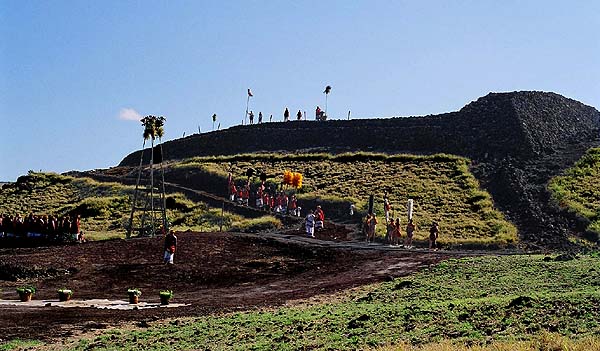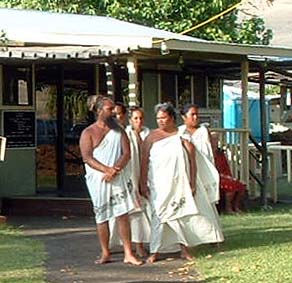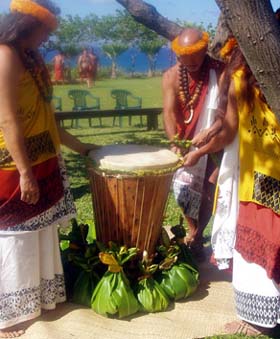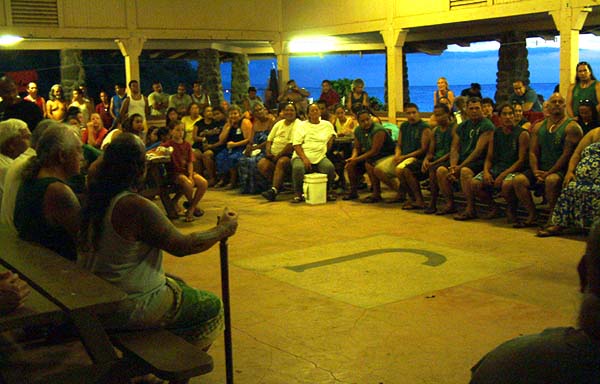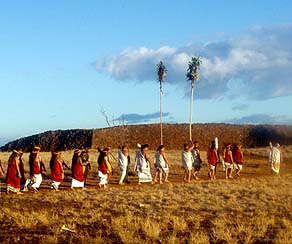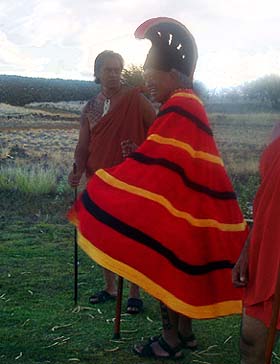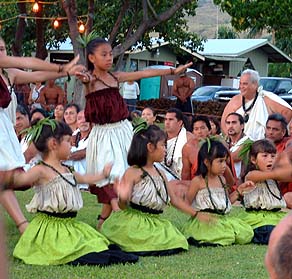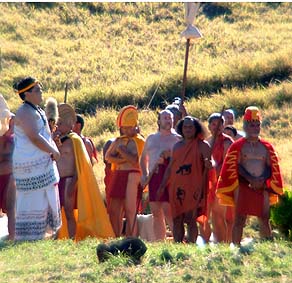 |
 |
 |
|||||
|
|
|||||||
"The recognition and the reusing of sites comes to a point of tension in today’s world," Hannah says, "when some of us would re-occupy or continue occupation of old sites with a contemporary vision based on traditional sensibility. Whether we are dealing with historic sites or material remains, I think it’s incumbent upon this generation, or the generations on either side of us, to craft a way that we have access to sites and materials for cultural practice."
|
||
|
|
||
"Pu‘u Kohola is certainly a very important place," Ku asserts, "not just for the people within this area of the island, or even just this island, but throughout the island chain. It’s a significant wahi pana [sacred site] and is recognized as such. It’s also one of our better preserved places. "Paka‘alana heiau in Waipi‘o, for example, had a similar significance. There is no trace of that visible anymore at all. So we’re very fortunate that Pu‘u Kohola is still in the state that it’s in, and we can definitely use that. "The hard part for us right now is that there are not necessarily the native caretakers that we would like there to be. We would like to see a native caretaker that is acknowledged not by a Western system but really by us as a people to be the caretaker of that place. Not having that limits the extent to which we can get involved in the various activities."
|
|
|
"One of our kuleana is to learn about the places and then to assist in taking care of those places with the hope that in the future we can fully take care of these places again. Because I strongly feel that it’s nobody else’s kuleana except for ours to take care of our wahi pana. "But I don’t think, as a people in general, we’re ready to do that yet. We don’t have the resources to do that yet. So we’re grateful to whoever is taking care of in the interim. But as we are strengthening from within, I really feel very strongly that it is just a matter of time until we want to go back to taking care of our own wahi pana. That is very consistent with other indigenous peoples throughout the world."
|
|
|
|
|
“We are talking responsibilities for all that Pu‘ukohola Heiau stood for," Mel explains. "In the past battles were between ruling chiefs and were always about supremacy. Kamehameha took on the commitment of bringing battles to an end. And in 1810, Hawai’i became a nation under one ruler, King Kamehameha. Today it is our responsibility to restore that nation that was illegally taken and assert ourselves to restoring the nation that was. Our Queen, Lili‘uokalani, once said, 'Never fear to act for fear that you will fail'."
|
||
|
|
||
“Pu‘u Kohola is the beginning of our nation. There was Kamehameha; and Keoua, he came to be sacrificed to consecrate that heiau for the benefit of all of us today. And I think we need to understand that. And how brutal the battles were—that’s our story. And there were stories like this in other parts of the world. And I think as Hawaiians we should look at that and put it away and move on. "My grandfather never told me anything negative about Pu‘u Kohola. In fact I never knew that was a temple when I was growing up. But when I was asked to participate in the 1991 ceremony, I thought about it. They were putting together a ceremony for the anniversary, and Sam Ka‘ai said maybe I should come, so I told him ‘O.K. I will pray about it, and I will come.’"
|
|
|
"So the next day, I said, ‘I got no problem going. My Tutu never told me anything negative about that. If anything, I read it in the books.’ So I went, and I felt comfortable." "That was the 1991 ceremony. And that was the first time I went up there—first time I got involved in anything. It’s the first time I put on a malo in my life! Malo is the culture. Because when you’re honoring ancestors and their culture, that was their dress. To do otherwise, I don’t think you are honoring them in their culture. "I’ve been involved now a long time. And I got married there. My wife died in ’93 and I got married, not on the heiau but outside of the heiau, in ’95. I met my new wife when we did the 200th anniversary of the Battle of Nu‘uanu. And when we started to talk about marriage, I was thinking, ‘I want to do this in honor of my grandfather.’ So I got married with the mahiole and all that."
|
|
|
|
Since 1991, Na Papa Kanaka o Pu‘u Kohola has coordinated with the National Park service to hold an annual commemorative ceremony at Pu‘u Kohola. This ceremony is held in August every year, and draws participants from all over the islands.The sequence of events for the ceremony is listed below. Thursday Night: Friday
Morning: Friday,
daytime:* Friday
afternoon: Saturday
morning:* Saturday,
daytime:* Saturday
evening:* Sunday morning:* *denotes events open to the public either as participants or observers.
|
||
|
|
||
“Kanu o Ka ‘Aina has a ‘native’ commitment to kokua [assist] wherever we can," Ku notes, "and that can take numerous forms. So we participate in the annual Cultural Festival and the ceremonies that are organized through Na Papa Kanaka o Pu‘u Kohola. We go down Thursday evening to camp out, and stay down there for the couple days. “We perform portions of our hula drama not just for
the core participants, but also for the general public in an effort
to educate about our history from a native perspective. That is something
that the majority of people in Hawai‘i have a very little opportunity
to encounter."
|
|
|
“We’ve got a good group of students, parents, teachers, and family members coming down and participating in the ceremonies. They also participate in the workshops, assisting with food donations and such, and assist with preparing the place for the ceremonies. We’ll go down and arrange the lele. The girls are going to be plaiting the coconut leaves for the plates. "So however we can help around those areas is something that we gladly do, because we feel it’s a reciprocal thing. And now the offerings that we’re able to give at Pu‘u Kohola are not things that we bought in the store, but are actually things that the students grew. It just makes it that much more authentic all around."
|
|
|
|
“Today they make a big thing out of the heiau,” Pua remarks. “They have ceremonies, and I think it’s great, I really do. I think that is wonderful for the kids to learn. It’s great because at least we’re bringing back history. And all our young ones that are growing up, at least they get something to study. A lot of children are using the heiau to study about Hawaiian culture and about the heiau, and what it stands for. "Today, when I look at the heiau, the archaeologists really restored it. It’s really nice. I look at the heiau from wherever I am, and ‘Oh, there’s Pu‘u Kohola heiau.’ "But I never in all my wildest dreaming, growing up, imagined that the heiau would finally come back to life.”
|
||
|
|
||
|
“We’re doing it because we need to educate the generation that goes on,” Papa states. “In the first place, we’re not responsible for the heiau, it’s the Park. The Park wants to keep tradition moving. So they have the responsibility. We are organized, but we have no power. We are just doing the responsibility with the Federal Government to keep the history alive. We are supporting that, and educating the Hawaiian people as well as the malihini [visitors] that come in.”
|
||
|
|
||
|
With these thoughts, we turn to depart Kawaihae.
|
||
|
|
||
|
|
|
|
|
|

|
| Kawaihae Home | Map Library | Site Map | Hawaiian Islands Home | Pacific Worlds Home |
|
|
|
|
|
|
|||
| Copyright 2006 Pacific Worlds & Associates • Usage Policy • Webmaster |
|||
